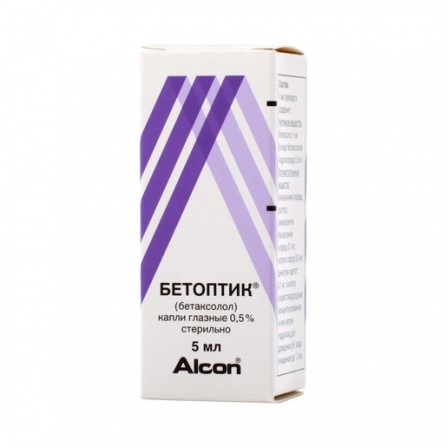Betoptic S eye drops 0.25% 5ml
Condition: New product
998 Items
Rating:
Be the first to write a review!

More info
Active ingredients
Betaxolol
Release form
Drops
Composition
Betaxolol 2.5 mg, betaxolol hydrochloride 2.8 mg, Excipients: benzalkonium chloride, mannitol, carbomer 974P, polystyrene sulphonic acid, boric acid, disodium edetate, N-lauroyl sarcosine, hydrochloric acid and / or sodium hydroxide solution (to maintain the level)) .
Pharmacological effect
Antiglaucoma drug. Selective beta1-adrenergic blocker without internal sympathomimetic activity. Does not have a membrane stabilizing (local anesthetic) effect. When applied topically, Betaxolol reduces intraocular pressure due to a decrease in the production of intraocular fluid. The onset of the hypotensive effect is observed 30 minutes after instillation, the maximum effect develops after 2 hours. After a single instillation, the effect on ophthalmotonus persists for 12 h.Betaxolol (compared to other beta-blockers) does not cause a decrease in blood flow in the optic nerve. The use of Betoptics C does not drive t rise to miosis, accommodation spasm, night blindness, shroud effect before the eyes (unlike miotikov).
Pharmacokinetics
With local use of the drug, systemic absorption of betaxolol hydrochloride is possible.
Indications
The drug is used to reduce intraocular pressure as monotherapy or in combination with other drugs for: - open-angle glaucoma; - ocular hypertension.
Contraindications
- sinus bradycardia; - AV-blockade II and III degree; - cardiogenic shock; - severe heart failure; - hypersensitivity to the drug components.
Precautionary measures
Do not exceed the recommended dose. With caution, you should prescribe the drug for diabetes, pheochromocytoma, Raynaud's syndrome.
Use during pregnancy and lactation
Sufficient experience with the drug Betoptic C during pregnancy and lactation is not. The use of the drug during pregnancy and lactation (breastfeeding) is possible only in the case when the intended benefit to the mother outweighs the potential risk to the fetus or child.
Dosage and administration
The drug is instilled into the conjunctival sac 1-2 drops 2 times / day. In some patients, the stabilization of intraocular pressure occurs within a few weeks, so it is recommended to control intraocular pressure during the first month of treatment. In case of insufficient clinical efficacy of monotherapy, you should prescribe a combination therapy. vial should be shaken.
Side effects
On the part of the organ of vision: often - short-term discomfort in the eyes after instillation; in some cases - blurred vision, punctate keratitis, decreased sensitivity of the cornea, foreign body sensation in the eye, tearing, photophobia, itching, dry eyes, red eyes, anisocoria, inflammation, pain, reduced visual acuity. CNS: insomnia, depressive neuroses .
Overdose
If an excessive amount of the drug gets into the eyes, wash the eyes with warm water.
Interaction with other drugs
With simultaneous use of the drug Betoptic C and beta-blockers for oral administration increases the risk of side effects (both local and systemic) due to the additive effect (therefore, patients receiving this combination of drugs should be under medical supervision). When using Betoptic C in in combination with catecholamine depleting drugs (such as reserpine), a decrease in blood pressure and bradycardia can be observed.
special instructions
The drug is prescribed with caution to patients with diabetes mellitus, since beta-blockers may mask the symptoms of acute hypoglycemia. With caution, the drug is prescribed to patients with thyrotoxicosis, since beta-blockers may mask the symptoms of thyrotoxicosis (for example, tachycardia). In patients with suspected thyrotoxicosis, beta-blockers should not be abruptly discontinued, since this may cause an increase in symptoms. It should be noted that beta-blockers can cause symptoms similar to those in myasthenia gravis (diplopia, ptosis, general weakness). Be careful that beta-blockers should be prescribed to patients with marked impairments of the respiratory system. Despite the fact that clinical studies have shown the absence of the effect of betaxolol on the function of external respiration, the possibility of increased sensitivity to the drug cannot be ruled out. Before a planned surgical operation, beta-adrenergic blockers should be gradually canceled 48 hours before general anesthesia, sinceDuring general anesthesia, they can reduce the sensitivity of the myocardium to sympathetic stimulation. Patients who use beta-blockers may have a history of atopy or anaphylactic reactions. In the case of the development of repeated hypersensitivity reactions, these patients may not be sensitive to the usual doses of epinephrine (adrenaline) needed to relieve anaphylaxis. When instilled into the eyes, beta-adrenoblockers can be absorbed into the systemic circulation. At the same time the same side effects can be noted, as well as at systemic use. Cases of severe respiratory and cardiovascular disorders, including fatal bronchospasm in patients with bronchial asthma and death from heart failure, are described. Betoptic C has almost no effect on blood pressure and heart rate. However, caution should be exercised in the appointment of the drug to patients with AV-blockade or heart failure. Treatment should be discontinued when symptoms of heart failure appear. Care should be taken when using betaxolol and adrenergic psychotropic drugs together. Betoptic C eye drops contain preservatives that can be deposited in soft contact lenses and have a damaging effect on the eye tissue. Therefore, patients wearing contact lenses should remove them before using drops and install them back no earlier than 20 minutes after instillation. When using the drug, avoid touching the pipette with any surface to avoid microbial contamination. Use in pediatrics Sufficient experience with Betoptic C children do not have. The effect on the ability to drive motor vehicles and control mechanisms. If after applying the droplets the patients' vision is temporarily reduced, until it is restored It is recommended to control the car and engage in activities that require attention and reaction.




